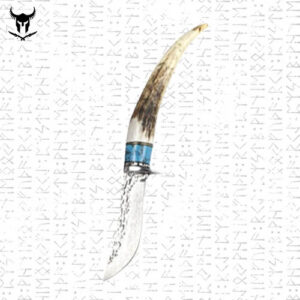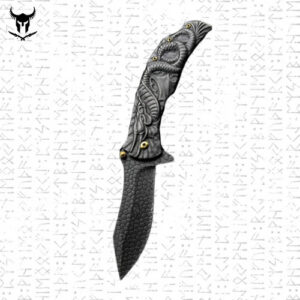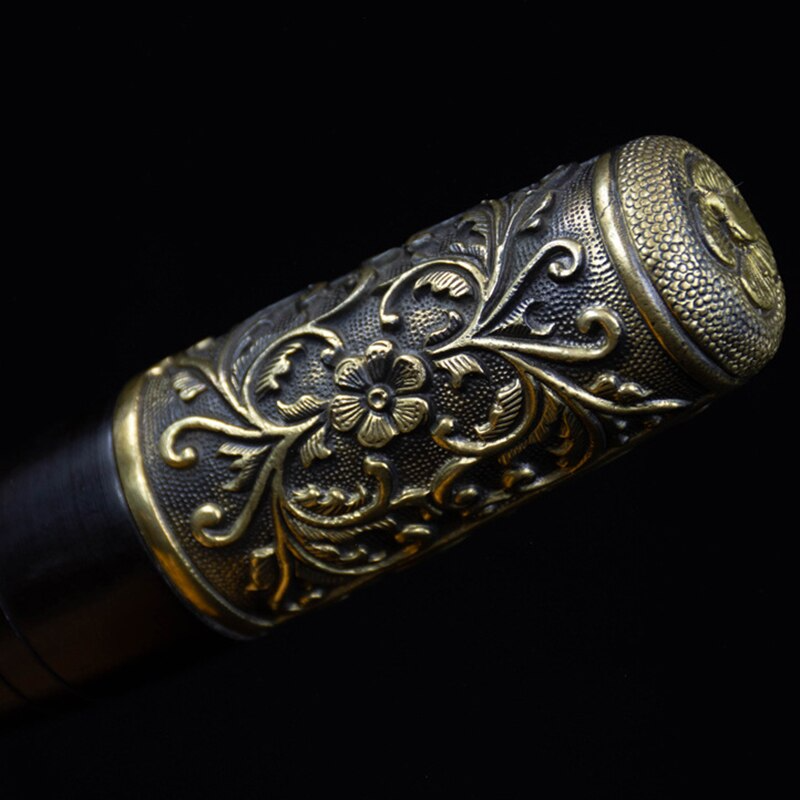If you’re a knife enthusiast, you’ve likely wondered, “Who made the very first knife?” This question opens a realm of inquiries—who had the idea to make a knife, what did the first knife look like, what is the oldest pocket knife, and how were the handle and details designed?
Summary
ToggleIf these questions intrigue you, we have everything you need to delve into the history of knives.
The oldest knife ever discovered is the Chachapoyan knife, estimated to be at least 9,000 years old. While the exact age of this knife remains uncertain, it is significantly older than modern pocket knives. In the late 1800s, the oldest known pocket knife was found in Hallstatt, Austria, featuring a single blade and a bone handle. Hallstatt, a village in modern-day Austria, was home to the Hallstatt culture, which thrived from the late Bronze Age to the early Iron Age (8th to 6th century BC).

Viking Hunting Knife Forged in Damascus Steel with Non-Slip Handle
⚒️ A blade, a legacy — forge yours now.
Buy nowThe Viking culture, known for its advanced metalworking, also produced knives that reflect their craftsmanship. Discoveries from Viking cemeteries reveal a treasure trove of artifacts, including knives that offer a glimpse into their sophisticated metalwork.
The Origin of the Knife
Knives have ancient origins. Archaeologists have found many blade knives in ancient Roman cities. Roman knives often featured bone handles, with materials ranging from bone and wood to metal.
The Origin of the Word “Knife”
The term “knife” entered English from the Old Norse word “kníf,” which means “a pointed and sharp weapon for cutting or chopping.” This word likely entered the English vocabulary around 1100 AD.
Did the Knife Come Before the Sword ?
Knives are among the earliest tools to use metal and have been used for both practical purposes and self-defense. Early knives were made from stone and copper, evolving from symmetrical double-edged daggers to single-edged blades around 4,000 years ago.
During the Roman Empire, many friction-folding bronze knives were discovered. These knives used friction rather than locks or springs to stay closed, requiring hand or thumb pressure to remain open.
A Brief History of Knives from the Early 1600s to 1990
- Early 1600s: The Gully knife, featuring a pistol grip, was used in combat and is named after the Gaelic word “gully,” referring to a small valley.
- Late 1600s: The Navajo knife, introduced during the Spanish Civil War, initially served as a multipurpose tool but later featured a locking mechanism, making it one of the earliest lockback knives.
- Early 18th Century: The butterfly knife, or balisong, was invented by the French and used for hunting. The Philippine version, known as sinturon, is crafted by hand and known for its quality and unique design.
- 1940s: The Italian stilettos, popularized in the US after WWII, became known for their automatic opening mechanism and were favored by gangsters.
- Late 1800s: The Japanese higonokami, a friction-folding knife, became popular for its versatility in tasks such as filleting and general cutting.
- 1950: The Schrade Stiletto switchblade was designed primarily as a weapon rather than a utility knife.
- 1990: Bob Terzuola invented tactical knives, designed for functionality and ease of use, often made from high-quality materials for durability.

Jörmungandr Hunting Knife with Midgard Serpent Pattern
⚒️ A blade, a legacy — forge yours now.
Buy nowWhen Was the Date Added to a Knife’s Sheath ?
The date system for knives changed in 1970, with the addition of “U.S.A.” to the letter “S” and a new numbering system. The actual date was stamped on the tang from 1990 to mid-1993.
How Long Has Benchmade Knife Company Been Around ?
Benchmade has been around for over 30 years, dedicated to making high-quality knives for various tasks. Their commitment to improving knife experiences and customer service has remained steadfast since their inception.
Conclusion
The history of knives spans from ancient stone tools to modern tactical designs, reflecting both the evolution of technology and craftsmanship. The oldest knives offer a fascinating glimpse into the past, while innovations over the centuries reveal the continuous improvement and adaptation of these essential tools. Whether for practical use or historical interest, knives hold a unique place in human history.

